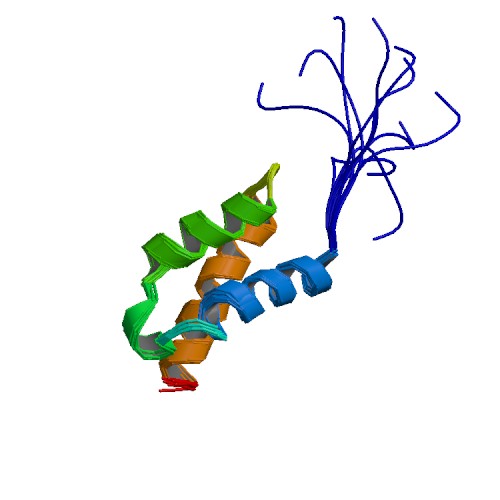DEK (gene)
| DEK oncogene (DNA binding) | |||||||||||||
|---|---|---|---|---|---|---|---|---|---|---|---|---|---|
 PDB rendering based on 1q1v. | |||||||||||||
| |||||||||||||
| Identifiers | |||||||||||||
| Symbols | DEK ; D6S231E | ||||||||||||
| External IDs | Template:OMIM5 Template:MGI HomoloGene: 2593 | ||||||||||||
| |||||||||||||
| RNA expression pattern | |||||||||||||
 | |||||||||||||
| More reference expression data | |||||||||||||
| Orthologs | |||||||||||||
| Template:GNF Ortholog box | |||||||||||||
| Species | Human | Mouse | |||||||||||
| Entrez | n/a | n/a | |||||||||||
| Ensembl | n/a | n/a | |||||||||||
| UniProt | n/a | n/a | |||||||||||
| RefSeq (mRNA) | n/a | n/a | |||||||||||
| RefSeq (protein) | n/a | n/a | |||||||||||
| Location (UCSC) | n/a | n/a | |||||||||||
| PubMed search | n/a | n/a | |||||||||||
DEK oncogene (DNA binding), also known as DEK, is a human gene.[1]
This gene encodes a protein with one SAP domain. This protein binds to cruciform and superhelical DNA and induces positive supercoils into closed circular DNA and is also involved in splice site selection during mRNA processing. Chromosomal aberrations involving this region, increased expression of this gene and the presence of antibodies against this protein are all associated with various diseases.[1]
References
Further reading
- von Lindern M, Fornerod M, Soekarman N; et al. (1993). "Translocation t(6;9) in acute non-lymphocytic leukaemia results in the formation of a DEK-CAN fusion gene". Baillieres Clin. Haematol. 5 (4): 857–79. PMID 1308167.
- Waldmann T, Scholten I, Kappes F; et al. (2005). "The DEK protein--an abundant and ubiquitous constituent of mammalian chromatin". Gene. 343 (1): 1–9. doi:10.1016/j.gene.2004.08.029. PMID 15563827.
- von Lindern M, Fornerod M, van Baal S; et al. (1992). "The translocation (6;9), associated with a specific subtype of acute myeloid leukemia, results in the fusion of two genes, dek and can, and the expression of a chimeric, leukemia-specific dek-can mRNA". Mol. Cell. Biol. 12 (4): 1687–97. PMID 1549122.
- Denisenko ON, O'Neill B, Ostrowski J; et al. (1996). "Zik1, a transcriptional repressor that interacts with the heterogeneous nuclear ribonucleoprotein particle K protein". J. Biol. Chem. 271 (44): 27701–6. PMID 8910362.
- Fu GK, Grosveld G, Markovitz DM (1997). "DEK, an autoantigen involved in a chromosomal translocation in acute myelogenous leukemia, binds to the HIV-2 enhancer". Proc. Natl. Acad. Sci. U.S.A. 94 (5): 1811–5. PMID 9050861.
- Murray KJ, Szer W, Grom AA; et al. (1997). "Antibodies to the 45 kDa DEK nuclear antigen in pauciarticular onset juvenile rheumatoid arthritis and iridocyclitis: selective association with MHC gene". J. Rheumatol. 24 (3): 560–7. PMID 9058666.
- Forero L, Zwirner NW, Fink CW; et al. (1999). "Juvenile arthritis, HLA-A2 and binding of DEK oncogene-peptides". Hum. Immunol. 59 (7): 443–50. PMID 9684994.
- Dong X, Michelis MA, Wang J; et al. (1998). "Autoantibodies to DEK oncoprotein in a patient with systemic lupus erythematosus and sarcoidosis". Arthritis Rheum. 41 (8): 1505–10. doi:10.1002/1529-0131(199808)41:8<1505::AID-ART23>3.0.CO;2-N. PMID 9704652.
- Wichmann I, Garcia-Lozano JR, Respaldiza N; et al. (1999). "Autoantibodies to transcriptional regulation proteins DEK and ALY in a patient with systemic lupus erythematosus". Hum. Immunol. 60 (1): 57–62. PMID 9952027.
- Alexiadis V, Waldmann T, Andersen J; et al. (2000). "The protein encoded by the proto-oncogene DEK changes the topology of chromatin and reduces the efficiency of DNA replication in a chromatin-specific manner". Genes Dev. 14 (11): 1308–12. PMID 10837023.
- McGarvey T, Rosonina E, McCracken S; et al. (2000). "The acute myeloid leukemia-associated protein, DEK, forms a splicing-dependent interaction with exon-product complexes". J. Cell Biol. 150 (2): 309–20. PMID 10908574.
- Grottke C, Mantwill K, Dietel M; et al. (2000). "Identification of differentially expressed genes in human melanoma cells with acquired resistance to various antineoplastic drugs". Int. J. Cancer. 88 (4): 535–46. PMID 11058868.
- Le Hir H, Izaurralde E, Maquat LE, Moore MJ (2001). "The spliceosome deposits multiple proteins 20-24 nucleotides upstream of mRNA exon-exon junctions". EMBO J. 19 (24): 6860–9. doi:10.1093/emboj/19.24.6860. PMID 11118221.
- Kappes F, Burger K, Baack M; et al. (2001). "Subcellular localization of the human proto-oncogene protein DEK". J. Biol. Chem. 276 (28): 26317–23. doi:10.1074/jbc.M100162200. PMID 11333257.
- Waldmann T, Eckerich C, Baack M, Gruss C (2002). "The ubiquitous chromatin protein DEK alters the structure of DNA by introducing positive supercoils". J. Biol. Chem. 277 (28): 24988–94. doi:10.1074/jbc.M204045200. PMID 11997399.
- Larramendy ML, Niini T, Elonen E; et al. (2003). "Overexpression of translocation-associated fusion genes of FGFRI, MYC, NPMI, and DEK, but absence of the translocations in acute myeloid leukemia. A microarray analysis". Haematologica. 87 (6): 569–77. PMID 12031912.
- Hollenbach AD, McPherson CJ, Mientjes EJ; et al. (2003). "Daxx and histone deacetylase II associate with chromatin through an interaction with core histones and the chromatin-associated protein Dek". J. Cell. Sci. 115 (Pt 16): 3319–30. PMID 12140263.
- Krithivas A, Fujimuro M, Weidner M; et al. (2002). "Protein interactions targeting the latency-associated nuclear antigen of Kaposi's sarcoma-associated herpesvirus to cell chromosomes". J. Virol. 76 (22): 11596–604. PMID 12388720.
- Strausberg RL, Feingold EA, Grouse LH; et al. (2003). "Generation and initial analysis of more than 15,000 full-length human and mouse cDNA sequences". Proc. Natl. Acad. Sci. U.S.A. 99 (26): 16899–903. doi:10.1073/pnas.242603899. PMID 12477932.
| This protein-related article is a stub. You can help Wikipedia by expanding it. |